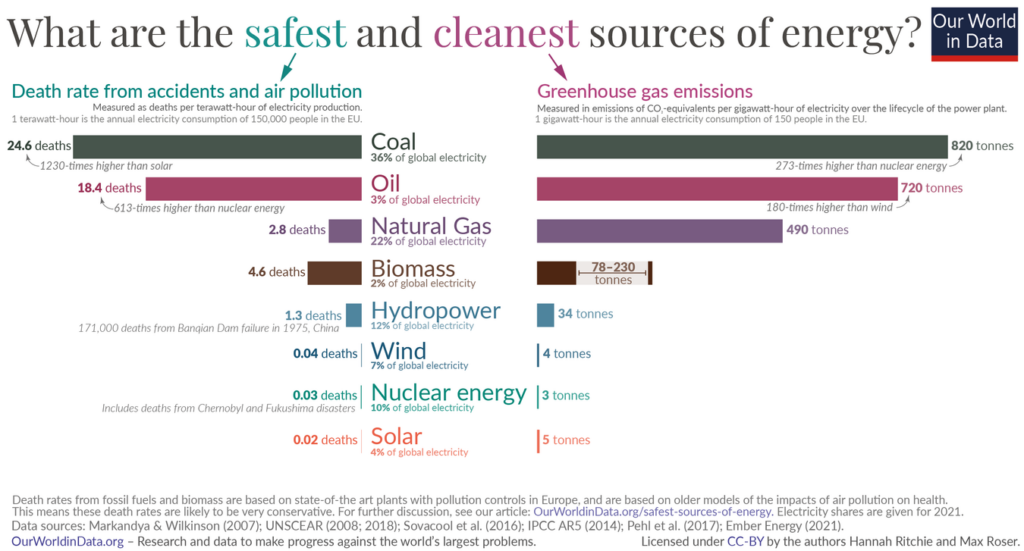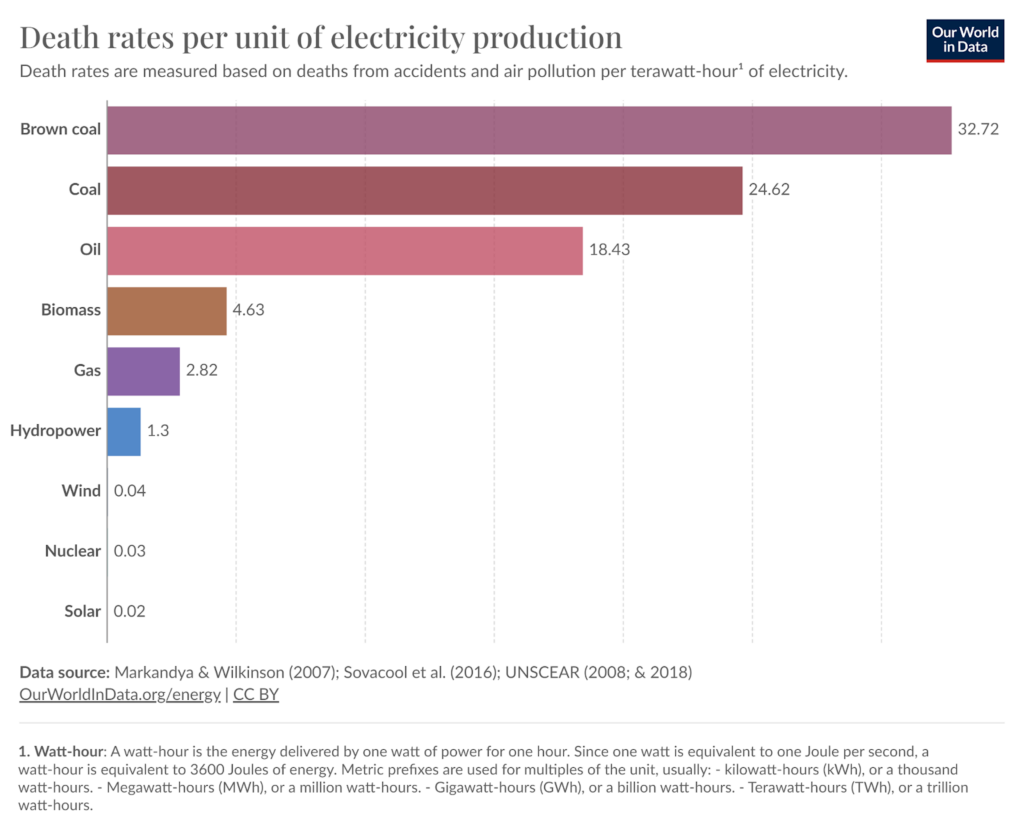How Safe Is Solar Energy? A Holistic Life-Cycle Analysis
Impactful Ninja is reader-supported. When you buy through links on our site, we may earn an affiliate commission.
Learn more
Learn more
.
Hey fellow impactful ninja ? You may have noticed that Impactful Ninja is all about providing helpful information to make a positive impact on the world and society. And that we love to link back to where we found all the information for each of our posts. Most of these links are informational-based for you to check out their primary sources with one click. But some of these links are so-called "affiliate links" to products that we recommend. First and foremost, because we believe that they add value to you. For example, when we wrote a post about the environmental impact of long showers, we came across an EPA recommendation to use WaterSense showerheads. So we linked to where you can find them. Or, for many of our posts, we also link to our favorite books on that topic so that you can get a much more holistic overview than one single blog post could provide. And when there is an affiliate program for these products, we sign up for it. For example, as Amazon Associates, we earn from qualifying purchases. First, and most importantly, we still only recommend products that we believe add value for you. When you buy something through one of our affiliate links, we may earn a small commission - but at no additional costs to you. And when you buy something through a link that is not an affiliate link, we won’t receive any commission but we’ll still be happy to have helped you. When we find products that we believe add value to you and the seller has an affiliate program, we sign up for it. When you buy something through one of our affiliate links, we may earn a small commission (at no extra costs to you). And at this point in time, all money is reinvested in sharing the most helpful content with you. This includes all operating costs for running this site and the content creation itself. You may have noticed by the way Impactful Ninja is operated that money is not the driving factor behind it. It is a passion project of mine and I love to share helpful information with you to make a positive impact on the world and society. However, it's a project in that I invest a lot of time and also quite some money. Eventually, my dream is to one day turn this passion project into my full-time job and provide even more helpful information. But that's still a long time to go. Stay impactful,Affiliate Disclosure
Why do we add these product links?
What do these affiliate links mean for you?
What do these affiliate links mean for us?
What does this mean for me personally?
![]()
Solar energy is a renewable and sustainable energy source that is important in reducing global GHG emissions and mitigating climate change. Over the years, it has come to make up an ever-growing part of our energy mix. So, we had to ask, How safe is solar energy really?
Overall, solar energy is considered to be safe. Holistically and throughout its life cycle, solar is safe and beneficial for human and animal health, the environment, and the energy grid. It is significantly safer than fossil fuels and other types of renewable energy.
Keep reading to find out how safe solar energy is overall, holistically, and in terms of its life cycle. Then, we’ll describe solar energy’s pros and cons, look at how effective it is, and determine how it can help mitigate climate change.
The Big Picture of the Safety of Solar Energy
Solar energy is the conversion of solar radiation into electrical energy either through the use of photovoltaic (PV) panels or solar radiation-concentrating mirrors. The energy produced is then used to generate electricity or can be stored in batteries or thermal storage for use at a later time.
“Solar Energy: energy that uses the power of the sun to produce electricity”
Cambridge Dictionary
Harnessing the power of the sun falls into two main categories:
- Photovoltaic (PV) solar cells: photovoltaic cells in solar panels absorb energy from sunlight, creating an electrical charge. This charge moves in response to an internal electric field in the cell, causing electricity to flow.
- Concentrating solar thermal plants (CSP): mirrors reflect and concentrate sunlight onto receivers that collect and convert solar energy into heat. This is utilized in very large power plants.
Both systems take the energy from the sun and convert it to electricity, just by slightly different mechanisms. PV solar is the main mechanism used today to harness solar energy.
“Safety: the condition of being protected from or unlikely to cause danger, risk, or injury”
Oxford Dictionary
| How Safe Is Solar Energy Overall | Overall, solar energy is a safe form of energy regarding human and animal health, the environment, the energy grid, and throughout all stages of its life cycle. |
| How Safe Is Solar Energy at a Holistic Level | Human and Animal Health: Solar energy is safe for human and animal health and can be made safer with proper siting, monitoring, and maintenance of solar facilities. Environment: Solar energy emits minimal greenhouse gas emissions and has a minimal effect on the environment. Energy Grid and Infrastructure: Solar energy is a safe and beneficial addition to our power grid. It promotes the decentralization of our energy supply, which increases power grid efficiency by reducing peak time usage and decreasing the likelihood of power outages. |
| How Safe Is Solar Energy Across Its Life-Cycle | Building: Safe work practices and proper training of solar professionals can mitigate any risks associated with constructing solar facilities. Operating and Maintaining: Solar energy is considered safe to operate and maintain because it does not harm human health or the environment when producing energy. Building Back: This final stage is considered to be safe overall, with the most common workplace hazards (lifting, trips and falls, electricity, and ladders) able to be mitigated by safe work practices. |
| How Safe Is Solar Energy In Comparison to Other Types of Energy | Solar energy is one of our safest forms of energy that has one of the lowest death rates from accidents and air pollution per unit of electricity generation. |
Here’s How Safe Solar Energy Is Holistically and Across Its Life-Cycles
One way to combat the current global climate crisis threatening Earth’s environmental, economic, and social health is to transition away from traditional fossil fuels and toward renewable energy sources, such as solar energy.
Just as with any energy source, it is important to understand how safe solar energy is before we implement it on a commercial scale. This involves analyzing all aspects of solar energy.
For this reason, we have split our analysis into the following categories:
- Overall safety
- Holistic safety
- Life-cycle safety
- Comparative safety
How Safe Is Solar Energy Overall
Overall, solar energy is a safe form of energy regarding human and animal health, the environment, the energy grid, and throughout all stages of its life cycle. Solar energy has a low carbon footprint and can be a beneficial addition to our power grid that can promote decentralization and reduce air pollution.
How Safe Is Solar Energy at a Holistic Level
PV solar installed capacity is to exceed natural gas by 2026 and coal by 2027, becoming the largest in the world. Because solar is predicted to become a dominant electricity source, it is important to understand how safe it is at a holistic level.
“Holistic: relating to the whole of something or to the total system instead of just to its parts”
Cambridge Dictionary
To understand how safe solar energy is holistically, we must take into account how it affects us, the environment, and our technology.
How Safe Is Solar Energy When It Comes to Human and Animal Health
Overall, solar energy is considered safe for human and animal health.
A main component of solar energy is electromagnetic radiation (EM) which emanates from solar panels. Solar panels and energy transmission lines emit very weak EM fields at levels comparable to emissions from a cell phone. The World Health Organization has extensively studied exposure to low-level EM fields and found no evidence that EM is detrimental to human health.
Decades of research have also established there is no link between solar energy and cancer. From small rooftop solar arrays to utility-scale solar farms, researchers have found no evidence that solar energy causes cancer, at any level of production. Solar energy can decrease health risks (e.g., lung cancer) because it offsets emissions from fossil fuel usage, which directly contributes to air pollution.
Residential solar panels pose little to no threat to wildlife, and utility-scale solar facilities can be constructed in such a way to minimally impact their surroundings. Raised platforms can allow animals to shelter underneath, bird diverters and wildlife fences can keep wildlife away, and creating wetlands and planting vegetation between rows of solar panels can increase wildlife habitat.
Ways to further increase the safety of solar facilities include performing environmental assessments before construction to determine the potential negative impacts of solar facilities and implementing regular monitoring and maintenance protocols.
Overall, solar energy is safe for human and animal health and can be made safer with proper siting, monitoring, and maintenance of solar facilities.
How Safe Is Solar Energy When It Comes to the Environment
Solar energy emits minimal greenhouse gas emissions and has a minimal effect on the environment, provided that proper siting of facilities and disposal of solar panels occurs.
Solar energy produces a fraction of the pollution and toxic chemicals that fossil fuels produce, helping to protect air quality. Rather than combusting toxic materials, solar energy facilities harness the energy of the sun to generate electricity. In terms of emissions, solar energy generates between 38 and 48 grams of CO2 equivalent per kWh of electricity produced and zero sulfur dioxide or nitrogen oxide emissions.
PV solar arrays constructed on top of residential or commercial buildings have a minimal land use impact, but utility-scale solar projects can have a large land use carbon footprint. A utility-scale PV solar plant can require 5-10 acres per megawatt of generating capacity, and concentrating solar plants typically require 10-15 acres. Clearing this land for construction can disturb natural habitats and degrade the land if proper measures are not followed.
Solar panels themselves can be classified as hazardous waste depending on the type of metals present in the semiconductor and solder. For example, lead, arsenic, and cadmium are considered detrimental to human health and the environment, at high levels, and are therefore classified as hazardous. If solar panels containing toxic metals are dumped into landfills, the metals may leach out into the environment.
Recycling end-of-life solar panels can help ensure any toxic chemicals do not leach out into the environment. Many of the components of solar panels can be recycled, including glass, aluminum, copper wire, and the plastic junction box. Specialty metals and silicon cells can also be separated and purified via chemical and electrical techniques.
How Safe Is Solar Energy When It Comes to the Energy Grid and Infrastructure
Solar energy is not only safe, but it is also a beneficial addition to our energy grid and supporting infrastructure. Solar energy promotes the decentralization of our energy supply, which increases power grid efficiency by reducing peak time usage and decreasing the likelihood of power outages.
Renewable energy, including solar energy, draws energy from various geographic locations, so the grid can distribute power from multiple plants.
Although the addition of large amounts of renewable energy to the grid at one time may seem like it would have a destabilizing effect, renewable energy becomes more predictable as it is added to the grid. This is thanks to the law of large numbers.
“Law of large numbers: as the number of identically distributed, randomly generated variables increases, their sample mean (average) approaches their theoretical mean.”
Britannica
In terms of renewable energy, the output of every solar panel that is connected to the power grid Is less volatile and more stable than the output of one individual generator. This decentralization in turn reduces peak time usage and decreases the likelihood of power outages. It also increases the efficiency of power production and power distribution.
How Safe Is Solar Energy Across Its Life-Cycle
To understand how safe solar energy is, we must look at its life cycle and how safe each stage is. This includes assessing the safety of solar energy’s building, operating and maintaining, and building back stages.
How Safe Is Solar Energy in the Building Stage
The building stage of solar energy involves constructing solar facilities and electricity delivery mechanisms.
This includes building the many components found in solar facilities including mirrors, heat-exchange fluid, receivers, engines, turbines, and generators as well as the transmission lines, transformers, and substations required for delivering electricity to consumers.
Safe work practices and proper training of solar professionals can mitigate any risks associated with constructing solar facilities.
How Safe Is Solar Energy in the Operating and Maintaining Stage
The operating and maintaining stage of solar energy includes the process by which solar facilities capture the sun’s rays and convert them into electricity.
Solar energy is considered safe to operate and maintain because it does not harm human health or the environment when producing energy.
Solar panels are typically installed by professional solar panel installers and come equipped with an automatic shut-off system in the event of physical or mechanical damage. This leads to minimal risks associated with the operation and maintenance of solar energy.
How Safe Is Solar Energy in the Building Back Stage
The building back stage of solar energy involves:
- Shutting down the solar panels and other mechanical equipment
- Removing the solar panels, mirrors, racks, foundations, and enclosures from the site
- Restoring the land or roof to its original state
This final stage is considered to be safe overall, with the most common workplace hazards (lifting, trips and falls, electricity, and ladders) able to be mitigated by safe work practices.
How Safe Is Solar Energy In Comparison to Other Types of Energy
Solar energy is one of the, if not the, safest forms of energy (fossil fuels and renewable energy included). Solar energy has a death rate of 0.02 deaths per terawatt-hour of electricity produced. This includes deaths resulting from accidents and air pollution.

To put it into perspective, a town powered entirely by solar energy with a population of 150,000 that uses one terawatt-hour of electricity per year would experience only 1 death from solar energy every 50 years. If that same town was powered entirely by coal, roughly 1,250 people would die prematurely in the same amount of time, mostly from air pollution – that’s about 25 people every year.

In short, solar energy is one of our safest forms of energy because it boasts one of the, if not the, lowest death rates per unit of electricity generation from accidents and air pollution.
What Are the 6 Pros and 4 Cons of Solar Energy
Solar energy is a renewable and sustainable energy source, has a low carbon footprint, protects air quality, is efficient, generates few waste products, has low maintenance costs, and promotes energy independence and security.
However, solar energy is also an intermittent energy source, faces high upfront and maintenance costs, and has specific land requirements.
These Are the 6 Pros of Solar Energy
Solar energy has various pros that make it effective at reducing carbon emissions.
| 6 Pros of Solar Energy | Quick Facts |
| #1: Solar energy is a renewable energy source | Solar energy is classified as a renewable energy source because the sun generates energy at a rate faster than we can consume it. It is also sustainable because it emits minimal greenhouse gas emissions (GHGs) and does not negatively affect the environment, provided that proper siting and disposal methods are followed. |
| #2: Solar energy has a low carbon footprint | Solar energy has the fifth-lowest carbon footprint out of all energy types. On a life-cycle basis, concentrating solar energy emits 38, PV roof solar energy emits 41, and PV utility solar energy emits 48 grams of CO2 equivalent per kWh of electricity produced. |
| #3: Solar energy protects air quality | Rather than combusting toxic materials like coal does, solar power plants harness the energy of the sun to generate electricity. PV panels and concentrating mirrors produce minimal greenhouse gasses and emit no sulfur dioxide or nitrogen oxides, thereby helping to protect air quality. |
| #4: Solar energy is efficient | Today’s PV solar cells have an average commercial energy conversion rate of 15-20%. In addition, solar energy is an efficient use of land, producing roughly 40 times more energy than one acre of corn devoted to ethanol production. |
| #5: Solar energy generates few waste products | Solar energy generates minimal CO2 and few other waste products upon operation, and solar panels can be recycled. |
| #6: Solar energy promotes energy independence and energy security | Solar energy can help us transition away from fossil fuels and towards an energy-independent future. |
These Are the 4 Cons of Solar Energy
Understanding the drawbacks of solar energy is important to mitigate climate change effectively.
| 4 Cons of Solar Energy | Quick Facts |
| #1: Solar energy is an intermittent energy source | The amount and availability of sunlight varies by location, time of day and year, and weather. The unpredictable nature of solar means we cannot rely on it fully to produce all of our energy. |
| #2: Solar energy has high upfront costs | The Solar Energy Industries Association estimates it costs roughly $25,000 to install an average-sized residential solar system in the US, before taking into account any tax incentives. Solar batteries can cost between $12,000 and $20,000 to install, depending on the type and size. |
| #3: Solar energy can be expensive to maintain | Routine solar panel maintenance can cost between $140-$180 per service, and solar panel cleaning can cost $25 per panel. Optional solar system monitoring, roof and solar panel repairs, and tree trimming can be additional hidden expenses. |
| #4: Solar energy has specific land requirements | Utility-scale solar farms require 5-15 flat, unobstructed acres of land close to major population centers for commercial energy generation. |
How Effective and Efficient Is Solar Energy
In terms of effectiveness, solar energy has a low carbon footprint, protects air quality, and promotes energy security and independence.
In terms of efficiency, solar energy is a renewable and sustainable energy source, increases the efficiency of the power grid, and generates few waste products. Solar panels also efficiently convert sunlight into energy.
Solar energy is effective because:
- Solar has the fifth-lowest carbon footprint out of all energy types. Concentrating solar energy emits 38, PV roof solar energy emits 41, and PV utility solar energy emits 48 grams of CO2 equivalent per kWh of electricity produced, on a life-cycle basis.
- Solar produces a fraction of the pollution and toxic chemicals that fossil fuels produce, helping to protect air quality.
- Solar can help us transition away from fossil fuels and towards an energy-independent future.
Solar energy is efficient because:
- Solar energy is a renewable and sustainable resource that can reduce emissions for generations to come.
- Solar energy boasts a high rate of efficiency per solar panel (15-20%) and is an efficient use of farmland.
- Solar energy promotes the decentralization of our energy supply which increases power grid efficiency by reducing peak time usage and decreasing the likelihood of power outages.
- Solar energy generates few waste products upon operation, and solar panels can be recycled.
How Can Solar Energy Help Mitigate Climate Change
Climate change is a severe, long-term consequence of fossil fuel combustion. If left untreated, atmospheric CO2 can remain there for tens of thousands of years and exacerbate the negative effects of climate change. Solar energy emits less CO2 upon operation than fossil fuels and can therefore reduce our total emissions.
How is Climate Change Defined
Climate change is arguably the most severe, long-term global impact of CO2. Every year, we emit approximately 37 billion tons of CO2. The carbon found in fossil fuels reacts with oxygen in the air to produce CO2.
“Climate change: changes in the earth’s weather, including changes in temperature, wind patterns, and rainfall, especially the increase in the temperature of the earth’s atmosphere that is caused by the increase of particular gasses, especially carbon dioxide.”
Oxford Dictionary
When carbon enters the atmosphere, it absorbs sunlight and solar radiation, trapping the heat and acting as an insulator for the planet.
Since the Industrial Revolution, Earth’s temperature has risen a little more than 1 degree Celsius (°C), or 2 degrees Fahrenheit (°F). Between 1880-1980 the global temperature rose by 0.07°C every 10 years. This rate has more than doubled since 1981, with a current global annual temperature rise of 0.18°C, or 0.32°F, for every 10 years.
How Does Solar Energy Specifically Help Mitigate Climate Change
The global average concentration of CO2 in the atmosphere today registers at over 400 parts per million, the highest ever recorded. Solar energy can help lower this concentration because it can replace some of the burning of fossil fuels (e.g., coal, oil, natural gas) with a cleaner form of renewable energy.
Solar emits roughly 0.05%-0.08% of the amount of CO2 (grams of CO2 equivalent per kWh) as fossil fuels. Solar also has a life-cycle global warming emission between 0.08 and 0.2 pounds of CO2 equivalent per kilowatt-hour (kWh), whilst coal power plants have an estimated emission between 1.4-3.6 pounds of CO2 equivalent per kWh.
Increasing solar energy usage can reduce CO2 emissions, and the more we reduce CO2 emissions, the more we combat the negative effects associated with climate change including temperature rise, sea-level rise, ice melting, and ocean acidification. When these rates are slowed, the earth’s biodiversity does not have to struggle to adapt to temperature and pH changes. People will not be displaced due to the flooding of coastal areas. And icebergs will continue to provide climate regulation.
Final Thoughts
At a holistic level, solar energy is considered to be a safe form of energy in terms of human and animal health, the environment, and the energy grid and supporting infrastructure. It has a low carbon footprint and can be a beneficial addition to our power grid that can promote decentralization and reduce air pollution.
Solar is also considered to be safe during its entire life cycle (building, operating and maintaining, and building back stages). Common hazards, including those associated with construction and electricity, can be mitigated by proper training and safe work practices.
Forging a sustainable planet for future generations will require us to increase renewable energy usage, and solar energy is a great place to start.
Stay impactful,

Sources
- How Does Solar Work? | Department of Energy
- How Does Solar Energy Work? From Source Til Energy Generation
- International Energy Agency: Solar
- Britannica: Electromagnetic radiation | Spectrum, Examples, & Types
- Cancer.net: Can Having Solar Panels or Living Near a Solar Farm Increase Your Cancer Risk?
- Ipsun Solar: Are Solar Panels Harmful to Your Health?
- Critter Control Boston: Do Solar Panels Harm Wildlife?
- Solar Energy Industries Association: Land Use & Solar Development
- Republic Of Solar: The Impact of Solar Energy on Wildlife and Biodiversity: Ensuring a Sustainable Balance
- World Nuclear Association: Carbon Dioxide Emissions From Electricity
- Union of Concerned Scientists: Environmental Impacts of Solar Power
- Our World of Energy: How much land does a solar power plant require?
- US Environmental Protection Agency: End-of-Life Solar Panels: Regulations and Management
- Global Solar Council: Solar Energy and its Countless Benefits for the Power Grid
- Electrical Academia: Difference between Traditional Power Grid and Smart Grid
- Britannica: Law of large numbers | Probability, Sampling & Estimation
- US Department of Energy: Solar and Resilience Basics
- International Renewable Energy Agency: Solar energy
- Occupational Safety and Health Administration: Green Job Hazards – Solar Energy
- Better Tomorrow Solar: Understanding the Safety of Solar Energy
- National Renewable Energy Laboratory: Best Practices at the End of the Photovoltaic System Performance Period
- DuraLabel: Solar Power Hazards & Safety Infographic
- Our World in Data: What are the safest and cleanest sources of energy?
- Our World in Data: Death rates per unit of electricity production
- Impactful Ninja: Solar Energy: All 6 Pros and 4 Cons Explained
- Impactful Ninja: Renewable Energy Explained: All You Need to Know
- Impactful Ninja: Sustainable Energy Explained: All You Need to Know
- Enel X: What is solar panel energy efficiency?
- Solar Reviews: Solar Energy Pros and Cons in 2024
- NerdWallet: What Do Solar Panels Cost and Are They Worth It?
- Forbes: How Much Do Solar Panels Cost In 2024?
- Coal Power Impacts | Union of Concerned Scientists
- US Environmental Protection Agency: Summary of the Energy Independence and Security Act
- Impactful Ninja: How Effective and Efficient Is Solar Energy?
- Natural Resources Defense Council: Global Warming 101
- United Nations Framework Convention on Climate Change: The Paris Agreement
- National Oceanic and Atmospheric Administration: Climate Change – Atmospheric Carbon Dioxide
- Impactful Ninja: Fossil Fuel Energy Explained: All You Need to Know
- Impactful Ninja: Coal Energy Explained: All You Need to Know
- Impactful Ninja: Oil Energy Explained: All You Need to Know
- Impactful Ninja: Natural Gas Energy Explained: All You Need to Know
- National Wildlife Federation: Climate Change




